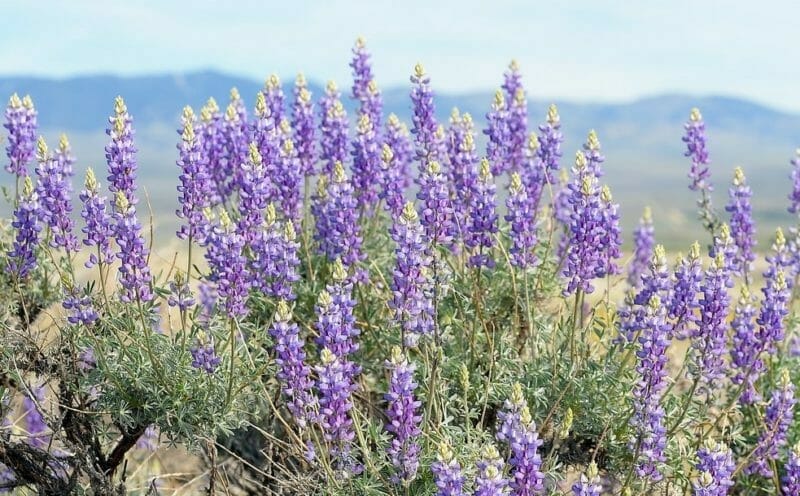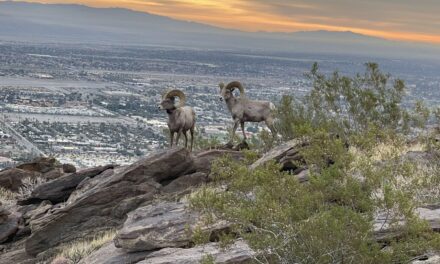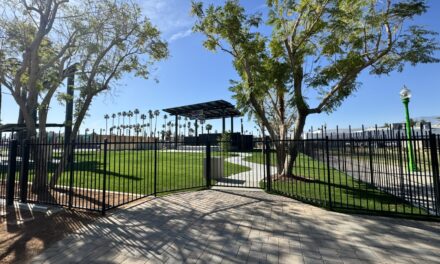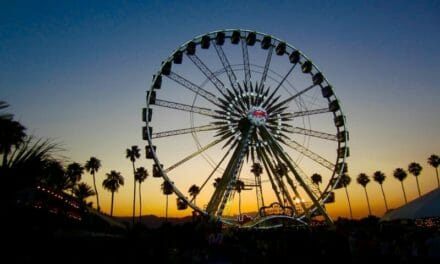Day hikers can explore the Indio Hills on a trail heading through two badlands and a desert plain.
The 4.4 miles round-trip lollipop trail sits north of Indio and east of the Coachella Valley Preserve-Thousand Palms Oasis Preserve. Informally known as the East Indio Hills Trail, it sports a 3 degrees average grade, with a high point of 529 feet.
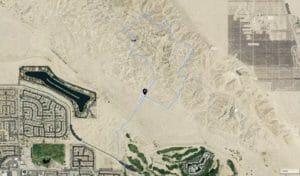
Indio Hills Badlands Trail map
To reach the trailhead, take either Calif. Hwy. 111 or Interstate 10 to Indio. Head north onto Golf Center Parkway. A parking lot is on the north side of the intersection with Avenue 42. Walk to the lot’s northeast corner and then go right/east alongside the Coachella Canal. Cross the bridge over the aqueduct at the edge of the Terra Lago golf course.
Immediately turn left and follow the trail toward the hills. About 800 feet in, you should be ascending a ridgeline that mainly runs north but at times leans slightly west.

The East Indio Hills sit in the distance from the trailhead.
The Indio Hills formed during the past 6 million years in much the same way as the nearby Mecca Hills. As the North American and Pacific tectonic plates slide against one another along the nearby San Andreas Fault, they cause land on either side of the meeting line to rise. Rain falling across the largely barren hills, as well as wind, then rushes through the soft rock.
The result are rock formations reminiscent of what you’d see at Badlands National Park in South Dakota: a lot of sharply angled, highly eroded mudrock; a few tiny arches etched out of the sandstone; and a lot of strange nooks and crannies high on canyon walls.
After crossing the first badlands area, the trail reaches a flat plain. Go across it in a northeasterly direction.
This region wasn’t always a dry wasteland. Fossils found during 2012 in the Indio Hills show that about 3 million years ago the area was much wetter. In fact, it may have been downright swampy in places. Among the fossil finds were alder, cattail, Douglas fir, oak, pine, spruce, willow, rodents and snails.
About 1.2 miles in as nearing the base of the next set of badlands, the stem reaches the loop. Go left-straight northeast into the hills.
Thanks to the San Andreas Fault, springs pop up all over the hills, creating several small oasis. Native California fan palm often thrive at these sites. None are along this trail, however.
Instead, the bulk of the trail meanders about 1.67 miles through badlands, heading through canyons and along ridgelines. As the elevation relief is greater here than in the first badlands crossed, so the rock formations also are more dramatic and fantastical.
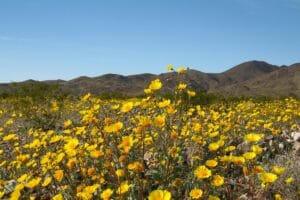
The yellow desert sunflower offers the perfect accent to purple lupine during their March bloom in the Coachella Valley.
While the tortured rock formations are the major draw, in March you’re sure to spot wildflowers along the trail, especially in the flat desert stretches. Purple lupine and yellow desert sunflower (also known as “desert gold”) both are in bloom.
Once the loop leaves the badlands (to find that spot, look for the metal towers rising out of the desert floor), turn right/northwest and follow the base of the hills for 0.33 miles back to the stem trail. From there, retrace your steps back to your vehicle.
Be forewarned that a number of trails crisscross the two badlands areas and plain. While the course here need not be folowed exactly, always bring a trail map and compass with you to ensure you know your location.
Also, none of the area is shaded. Given this, always don sunscreen, sunglasses and a sunhat, as well as bring plenty of water.
Image Sources
- Indio Hills Badlands Trail map: Rob Bignell
- 01 The East Indio Hills sit in the distance from the trailhead.: Rob Bignell
- The yellow desert sunflower offers the perfect accent to purple lupine during their March bloom in the Coachella Valley.: Rob Bignell
- Purple lupine blooms during March in wetter areas along the East Indio Hills Trail.: Rob Bignell

